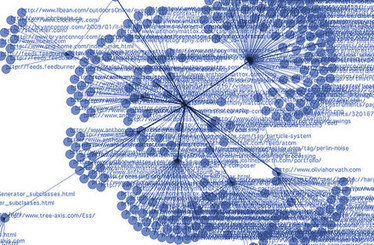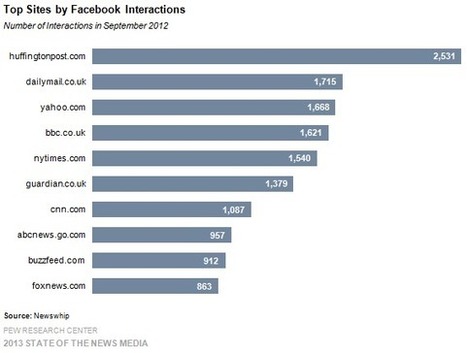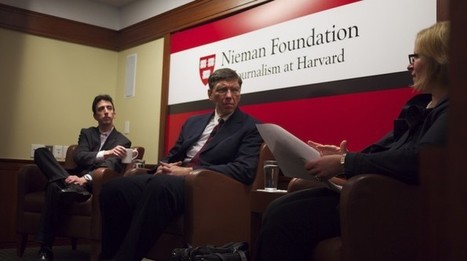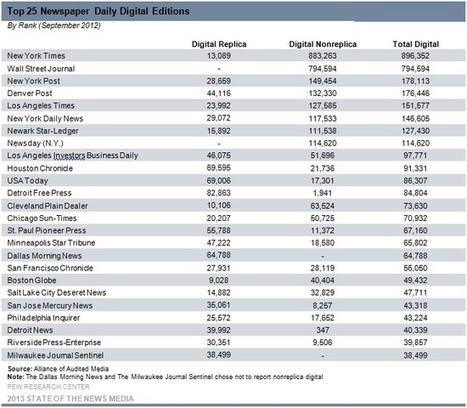 Your new post is loading...
 Your new post is loading...
Digital news continues to evolve, pushed by a variety of innovations in recent years, from groundbreaking new technologies like virtual reality and automated reporting to experiments on social platforms that have altered campaign coverage. As journalists and media practitioners gather for the annual Online News Association Conference, here are 10 key findings from recent Pew Research Center surveys and analyses that show how these rapid digital shifts are reshaping Americans’ news habits...
What's up with traditional media and what's buzzing in digital media? A very interesting analysis... It’s been a good week for old media. The Guardian, The Washington Post, The New York Times, and The Wall Street Journal have all done a superb job of reporting on the NSA/PRISM revelations. Unfortunately it has also been a terrible decade for them. Newspaper advertising revenue has fallen by more than half since 2007, and paywalls aren’t even coming close to covering that loss.Worse yet, nimbler competitors are doing their breakneck best to steal the audience…and they seem to be doing it well.
I recently got curious about how frequently various news sources are shared on social media, and since I couldn’t find any tool that measured quite what I wanted, I built one myself. (And I’ve spent like a hundred dollars on App Engine server costs amassing all of its data, so I hope you appreciate this.) The results were eye-opening.My handy-dandy tool, called Scanvine, tracks stories from a panoply of online sources, measures how often they’re shared, and compares and ranks them all. Guess what its leaderboard says as of this writing? None of the above are ranked in the top three. Nor the NYT, or the WSJ, or the New Yorker. Instead, third place goes to The Onion, with an average of 2000 shares per story; number two is Cracked, with 2700; and number one, at over 3000…is much-loathed BuzzFeed....
The media industry may be hurting, but journalism -- and access to information -- is flourishing. Journalists may just have to work smarter, and network more, to keep up.... Journalism is not in crisis. The media industry — and journalists — might be, but the journalism itself is actually improving. Such is the argument made by international documentary filmmaker Bregtje van der Haak and Annenberg professors Michael Parks and Manuel Castells in a recently published article about “Networked Journalism.” As the authors see it, the problem is that most of the doomsayers mix the concept of journalism with the business of journalism. In their article, journalism is defined as the “production of reliable information and analysis needed for the adequate performance of a democratic society.” Not mentioned in the definition are “profits,” “professional journalists” or “traditional publishers.” Just the pursuit of reliable information....
Traditional news organizations need to embrace the disruption brought by digital culture -- or they risk becoming obsolete. That was the message late last week at the International Symposium on Online Journalism hosted by the Knight Center for Journalism in the Americas at the University of Texas at Austin, where about 370 of the world's journalists, researchers and media watchers grappled with the hard questions for a beleaguered traditional media industry that is now more than a decade into its disruptive transformation. The problem is many media companies view digital technologies through a lens of traditional journalism and thus, fail to strategize properly, said Clark Gilbert, president and CEO of Deseret News Publishing Company. "In a post-disruption world, why would people pick up a paper at all? Why would someone turn on the 10 o'clock newscast?" Gilbert asked. "If you are not asking those fundamental questions, there is not a future for you legacy organization." The key to surviving? Innovate. Fail. Innovate again....
In the wake of the Boston Marathon, I have but one ask for the media: please tell us NO.... ... While Twitter might offer up a 6-second video of one of yesterday’s horrific explosions, it’s your profession that is charged with relaying that information. In the race for clicks, pageviews, and traffic, I’ve seen the most trusted news sources with banner three-letter monikers devolve into sensationalized sites catering to this now now now generation’s demand for anything. “Anything — just give us anything,” we cry. But it would be lovely if you told us “no.” No – we will not capitalize on over-graphic images that would get a Hollywood blockbuster an R-rating. No – we will not use cultural or nationality indicators when reporting that there is a suspect in custody. Why? Because we know the most important words in those statements are “in” and “custody” as opposed to where one was born or the depth of one’s suntan....
When Facebook introduced its redesigned News Feed, it did more than change how people view memes and photos of cats — it altered the way stories are seen. Now everyone can make news. But for those who make a living by spreading news, Facebook has changed the way stories are presented. Dean Praetorius, a senior editor with The Huffington Post, talked with AllFacebook about how the way news is presented on Facebook requires some changes to the traditional approach. The Huffington Post has recently been lauded for its popularity on Facebook. Pew Research Center presented findings regarding news and social media, citing a study by Newswhip showing that the online newspaper was by far the most engaged news source on Facebook. In terms of Facebook interactions, HuffPost beat out more traditional companies, such as The Daily Mail, The New York Times, and CNN. How did HuffPost accomplish this? Praetorius said that the company has taken a well-rounded approach to social media, knowing that the story is far from completed when it’s published. HuffPost also thinks about stories differently from print media outlets and TV stations. Praetorius said that stories on the site are meant to generate conversation, and not so much to simply inform, as an old-school newspaper would...
When to trust a theory over hard data, why companies that try to do too much get picked apart by competitors, and why sometimes industries have to learn the same lessons over and over. ...Skok said news organizations often do study their history, but they don’t focus enough on what’s coming next. Looking at profit and loss statements every quarter emphasize a snapshot of the past; Clay’s work says no, don’t only trust that balance sheet — trust a theory to predict what will happen in the future. But the idea of running large companies based on theories over hard numbers is a tough sell, Skok said. As disruption occurs, it commoditizes layers in the value stack — what used to be a high-value-added activity, one others couldn’t easily replicate, becomes cheap and easy. In journalism, the Internet, wireless technology, and other technologies have broadened the market for information. As a result, Christensen said, everyone has access to more information than they could possibly use. But that doesn’t mean that the whole indusry has become commoditzed and profitable: Commoditization opens up opportunities in adjacent layers in the value stack, he said. What you thought was a commodity becomes more profitable and proprietary — so even as one business dies, it opens up new opportunities. He cited the example of Forbes, whose previous core business — a print magazine — has been commoditized, but which has made interesting new moves online....
...So, all in all, it’s more than instructive to check in on longform newspaper writing, and the start of a new year isn’t a bad time to do it. And it’s pretty to shocking to see what’s become of the time-honored form since the newspaper industry’s great unraveling started a decade ago. The Los Angeles Times, for instance, published 256 stories longer than 2,000 words last year, compared to 1,776 in 2003—a drop of 86 percent, according to searches of the Factiva database. The Washington Post published 1,378 stories over 2,000 words last year, about half as many as 2003 when it published 2,755. The Wall Street Journal, which pioneered the longform narrative in American newspapers, published 35 percent fewer stories over 2,000 words last year from a decade ago, 468 from 721. When it comes to stories longer than 3,000 words, the three papers showed even sharper declines. The WSJ’s total is down 70 percent to 25 stories, from 87 a decade ago, and the LA Times down fully 90 percent to 34 from 368....
|
Election night is the time when everyone has CNN on. We’re the place to go for TV and digital, and we also want to be the place to go on social. We’re working on that, and we have a lot of fun things planned for election night.
We’re going to be very conscious of reaching our audiences across Facebook, Snapchat and Twitter. But we’re also going to live up to the CNN standard. We will work together as a multi-platform media company to make the calls at the right time.
We saw this play out in the primaries, where we made the calls across TV, digital and social at the exact same time. So we work together as a unit to make sure as a network, we make that call in unison. The same will happen on election night. All of social and digital and TV will be working to make sure there’s a crescendo of results as they happen....
When it comes to the traditional media business, there is often a pervasive nostalgia for “the good old days,” when a handful of newspapers and TV networks ruled over the media landscape and profitability was so taken for granted that huge family dynasties with names like Sulzberger and Bancroft were built on that foundation. Many media executives no doubt dream about magically returning to such a time. But what if those days were just an illusion — a kind of accident of history? What would that mean for the future of media? This idea has come up before, but I was reminded of it when I read a Nieman Journalism Lab post about some research being done by Lee Humphreys, looking at the way that communication — and particularly personal communication, through letters and diaries and other pre-digital tools of expression. Although this doesn’t seem to have much to do with how we use ultra-modern services like Twitter or Facebook, there is a lot more to it than you might think....
For a time, Gabrielle Giffords was dead. So was Newtown, Connecticut, shooter Adam Lanza’s father. Or maybe it was his brother in Hoboken, New Jersey. All three, as we now know, are alive. Two of them weren’t even shot. On the other hand, the alleged Boston Marathon bomber is, actually, under arrest. Then he wasn’t. Then he was. How does the news get it so wrong? I’ve spent almost 20 years as a reporter and anchor and have covered more live, fast-breaking stories than I remember. Mistakes happen regularly on cable news because of the inexact and unreliable nature of rolling coverage. But most of the mistakes don’t matter: the exact color of the car, the exact price of the stock, the exact quote from the courtroom. Ultimately, they all get corrected, as rumor and speculation give way to provable fact and hard evidence. Most of the mistakes end up being of little consequence. But the details surrounding the Boston bomber mattered, because the nation was so heavily invested. Americans were on edge, their sense of safety shattered again. Public anxiety was at its height when the news of an arrest first came. The news, it turns out, was wrong. And this one didn’t fix itself....
Guardian digital development editor Joanna Geary answers some questions about GuardianWitness.... ...First up: this was built in two months. The sponsorship pot from EE gave them a budget and time to get the job done, but not necessarily have everything they wanted at launch. She says it's a complete, working system that can be built upon. I suggest the phrase "minimum viable product" to Jo but she suggests that it's a full product - one that will be built on. Do they have aspirations for more integration with social media? Yes, they do. And it's something they're looking at as the system develops. The key part of the development which is invisible to us right now is that the Guardian Witness system is deeply integrated with the Guardian's CMS. Once the content has passed through verification, it's available to the journalists, and they can insert it into a story or liveblog just by inserting an URL, which creates an embedded version of the contribution that links back to the contributor's profile. "The really exciting thing is not what you see now, but what you see when Witness is included in a story," she says. It's a tool to facilitate genuine collaborative working between the journalist and external witnesses. Jo says they'll collaborate with people on the ground, or with expert knowledge, in any way they can - and already do, via phone and other traditional methods. This adds another tool for doing that....
Terrible events such as yesterday’s bombings at the Boston Marathon have always meant “all hands on deck” for news organizations, with staffers pulled off their regular beats to contribute. But the endpoint of the newsgathering and reporting is no longer a front-page package of stories explaining — the best one can — what happened, why it happened and what might be next. Now, there is no endpoint — events are reported in real time, with stories in constant motion, and the front page is a snapshot of an organization’s reporting at the moment when the presses needed to roll. Boston was a reminder of that, and a look at what’s changing in real-time journalism. Through Twitter and various live blogs, I found myself looking over my shoulder at the Boston Globe, the New York Times, Reuters and other news organizations, and was able to make some observations and draw some conclusions....
If the newspaper industry had theme music in 2013, it might use “Been down so long it looks like up to me,” the much-recycled line from a 1920s blues song. For the first time since the deep recession that began in 2007, newspaper organizations have grounds for a modicum of optimism... Companies have started to experiment in a big way with a variety of new revenue streams and major organizational changes. Some of the bright opportunities – such as offering social marketing services to local businesses – are ventures too new to be measured yet industry-wide. They show signs of stabilizing revenue.... Even halting improvement in the general economy helps the industry. The double whammy of cyclical ad losses on top of secular shift to new media has considerably eased from the worst of the recession from 2007 to 2010. Auto advertising has come back, and some markets, like Miami, are beginning to see recovery in real estate and employment ads as well. All those positives, however, are for the time being mostly promise rather than performance. The most basic indicators have not turned around. The industry is little more than half the size it once was. Considerable dangers persist... So the industry entered 2013 with some positive signs but still dealing with difficult economic realities. The two biggest newspaper developments of the last year – digital paywalls and reduced print frequency – capture that odd mix of expansion and contraction now typical within the industry....
...Ad-supported journalism is being consumed in record quantities, but those of us who manage media companies face a stark reality: Traditional advertising dollars in print and broadcast become dimes on the full-scale web, and they tend to disappear entirely on mobile devices. Alternative revenue models, then, are key to success, but only if they follow ethics guidelines that protect media outlets from losing credibility with readers. Sponsored content, as it is now being published on the full-scale and mobile web, differs from old-fashioned print advertorial in significant ways. The biggest departure is that, rather than passively receiving and publishing advertorial copy from ad agencies, media outlets are more often partnering with brands to create custom-content “native advertising” campaigns that resonate with readers who fit the publication’s demographic profile. BuzzFeed, for instance, employs a large staff to craft brand-marketing pieces that readers will share with friends via Facebook and other social networks. One such recent post, “11 Things No One Wants To See You Instagram,” quickly drew 330,000 views on behalf of advertiser Virgin Mobile, the Wall Street Journal reported. Similarly, Forbes Media created a Forbes BrandVoice program through which brands can submit paid articles to the Forbes website. “The advertiser-sponsored copy appears in the same style and format as articles contributed by Forbes writers and editors,” New York Post media columnist Keith J. Kelly reported in November. (The BrandVoice connection is noted at the top of posts.) This is a Wild West moment for sponsored content...
|



 Your new post is loading...
Your new post is loading...





















Pew Research provides valuable insight into the changing digital news landscape. rrecommended reading for PR, journalists and marketers. 9/10